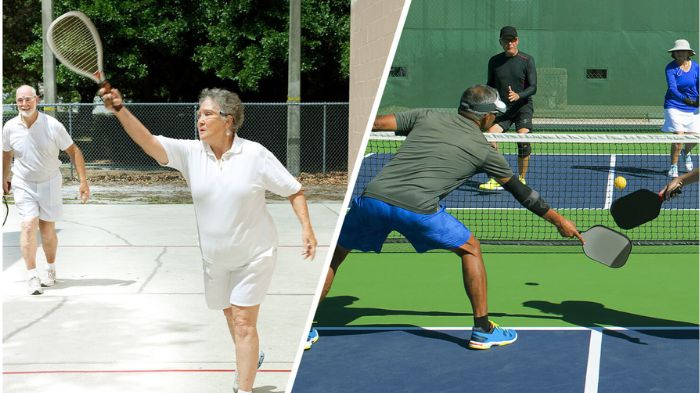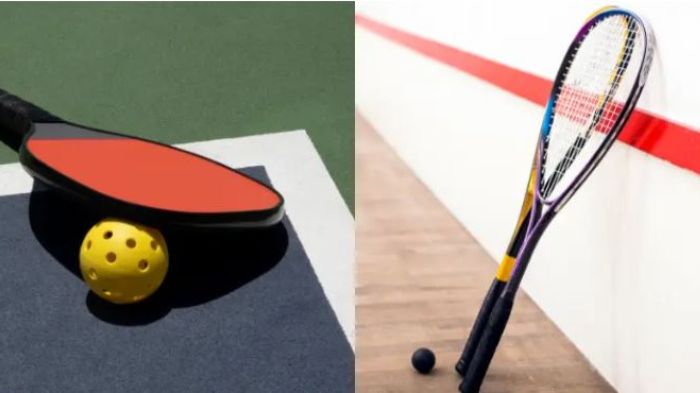Are you a fan of racket sports but can’t decide between pickleball and racquetball? Both games offer unique challenges and excitement that make them popular among players. While they may seem similar at first glance, there are distinct differences between the two that could sway your decision.
In this blog post, we’ll explore the similarities and differences between pickleball and racquetball to help you choose which one is right for you. So grab your paddles or rackets, and let’s dive in.

What Is Pickleball?
Pickleball, a racquet sport that originated in the mid-1960s on Bainbridge Island, Washington, is quickly gaining popularity. It’s a fast-paced game that combines elements of tennis, badminton, and ping pong, and can be played indoors or outdoors.
The court measures 20 feet wide by 44 feet long for doubles play and 20 feet wide by 22 feet long for singles play, with the net set at 36 inches high at the sidelines and 34 inches high in the center. Players use paddles made of wood or composite materials to hit a lightweight ball over the net, aiming to prevent it from being returned by their opponent.
Whether you’re a beginner or a seasoned player, Pickleball provides a fun and challenging experience for all ages and skill levels.
What Is Racquetball?
Racquetball is a thrilling and fast-paced sport that requires speed, agility, and quick decision-making skills. Invented in the United States by Joe Sobek in 1950, racquetball has become one of the most intense sports around.
The aim is to hit a small rubber ball against the front wall so that it bounces back towards your opponent, who then has to hit it back against the wall without letting it bounce twice on their side of the court.
Players can earn points when their opponents fail to return or make errors during play. Racquetball is a fantastic cardiovascular workout that challenges players both physically and mentally.
Similarities Between Pickleball and Racquetball
| Features | Pickleball | Racquetball |
|---|---|---|
| Court Size | 20 feet x 44 feet (doubles), 20 feet x 22 feet (singles) | 20 feet x 40 feet (doubles), 20 feet x 20 feet (singles) |
| Equipment | Paddles made of wood or composite materials with larger hitting surface | Racquets made of lightweight materials such as graphite |
| Ball | Lightweight plastic ball with holes to reduce wind resistance | Slightly heavier rubber ball |
| Scoring | Games are typically played to 11 points and points are scored on any serve | Games are typically played to 15 points and points are scored when a player fails to return the ball |
| Gameplay | Underhand and diagonal serve, ball must bounce once on receiving side before it can be hit back | Overhand or underhand serve, ball can be hit directly after it bounces or before it bounces |
| Pace of Game | Slower-paced, more emphasis on strategy and finesse | Faster-paced, more emphasis on speed and agility |
| Fitness Goals | Provides a moderate level of exercise and is suitable for those who prefer less running and focus on strategy | Offers a high level of exercise and is ideal for those who prefer a faster-paced game with more running and agility |
| Socialization | Often played in doubles or triples and is a great social activity | Intense and competitive, usually played one-on-one |
Court Size
Both Pickleball and Racquetball are played on indoor or outdoor courts with similar dimensions. The court sizes differ slightly for doubles and singles play. A pickleball court for doubles play is 20 feet wide and 44 feet long, while a racquetball court for doubles play is 20 feet wide and 40 feet long.
For singles play, a pickleball court is 20 feet wide and 22 feet long, while a racquetball court is 20 feet wide and 20 feet long. Both sports use the front wall of the court for hitting the ball.
Equipment
Both pickleball and racquetball call for players to strike a little ball back and forth across the court while using paddles or racquets. In contrast to racquetball racquets, pickleball paddles are often made of wood or composite materials and have a larger hitting surface.
The lighter-weight racquets used in racquetball are composed of graphite and are more aerodynamic for quicker swings.
balls
Pickleball balls are composed of plastic, are lightweight, and include perforations that let the wind pass through them more easily. The racquetball ball, on the other hand, is slightly heavier and made of rubber.
scoring
Both games use rally scoring to decide the winner, allowing players to score on any serve rather than just their own. Pickleball matches are typically played to a score of 11, and points are awarded when a team fails to return the ball. Racquetball matches are typically played for 15 points, and players score points for mishandling the ball.
Both sports involve striking a ball back and forth across the court, but the rules and tactics vary greatly between them. Pickleball requires an underhand, diagonal serve, and for the ball to be returned, it must first bounce once on the receiving side. The serve in racquetball can be struck overhand or underhand, and the ball can be hit directly after it bounces or before it bounces.
Differences Between Pickleball and Racquetball

- When it comes to differences between pickleball and racquetball, there are several aspects that set them apart. Firstly, the equipment used in both sports is different. While pickleball requires a paddle made of wood or composite materials and a plastic ball with holes, racquetball uses a stringed racquet and rubber ball.
- Another noticeable difference is the size of the courts used for each sport. Pickleball courts are smaller than racquetball courts, measuring 20 feet by 44 feet compared to 20 feet by 60 feet respectively.
- Moreover, the playing style also varies in these two games. Pickleball involves using less power and more control over shots as opposed to racquetball’s high-speed shots requiring greater strength and agility from players.
- The scoring system differs too. In pickleball games usually played up to eleven points while in Racquet Ball is generally played first player reaching fifteen points wins unless tied on fourteen-all when they play sudden death points till someone wins two clear points.
- In summary, despite having similarities including being indoor court-based racket sports played with small balls involving hitting against walls but there are some significant differences between these two popular games that make them unique in their own way
Also Read About: How to play pickleball on beach? And Funny pickleball memes
Which one is better?
The choice between pickleball and racquetball ultimately depends on personal preference. Pickleball offers a slower-paced game with a focus on strategy and finesse, making it a great choice for those who want to socialize and have fun while playing. But it is questionable to play or not in some cases such as can you play pickleball with bad knees?
Racquetball, on the other hand, offers a faster-paced game that emphasizes speed and agility, making it ideal for those who want a more intense workout and one-on-one competition. Both sports provide unique challenges and benefits, and both are excellent forms of exercise.
Whether you prefer the social aspect of pickleball or the intensity of racquetball, the decision comes down to what you value most in a sport.
Conclusion
In conclusion, both Pickleball and Racquetball offer their own unique advantages and appeal to different types of players. Whether you prefer the slower pace and strategic gameplay of Pickleball or the faster and more physically demanding nature of Racquetball, the choice ultimately comes down to personal preference.
Both sports offer great opportunities for exercise, socialization, and enjoyment, so why not give them both a try and see which one becomes your new favorite pastime? With so many similarities yet distinct differences, you might just be surprised at which one you end up loving.



